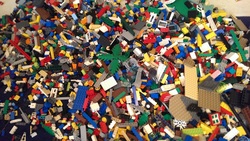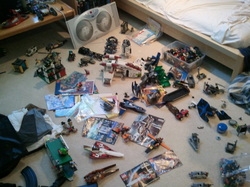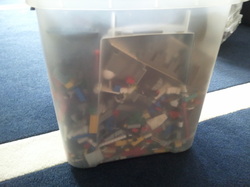
Now that you have pulled out anything that has been built, its time to get your hands really into that pile and amass the true value. Hopefully, you were able to find a few figures and a few sets that were not complete earlier, and you have a general idea of what you need to look for. To start, dump the entire bin out. Every single piece, put it on a nice large sheet (bed sheets work great for being able to dump all the pieces back in the bin later). Start in one corner, and shift through the pieces. Take out (in order of priority):
- Any minifig pieces. Heads, bodies, torsos, hands. These will be invaluable to repair the minifigs in your sets, and also hold the most value overall.
- Any minifig accessories. Pickaxes, flames, guns, tools. These can be used to spruce up figures, and often sell nicely in bulk.
- Non-Lego. If there are non-lego pieces like Megablox, make sure you put them to the side to discard them. Selling bulk Lego is often contingent on the fact that you haven't upped the weight with non-Lego pieces.
- Junk. Along the same lines as above, there should be no batteries, pencil lead pieces or coins in the Lego. Inevitably these always end up in the bin, and now you'll have to sort them out.
- Baseplates. Anything larger than 8x8 should come out. If you are feeling especially ambitious, any flat plate can come out, as they can be sold in bulk.
- Rare pieces that have patterns on them. Anything with a sticker should come out, as well as any piece that has a pattern on it or printing. These can be used to identify sets that may have gotten broken up. Also, if you have time, these pieces listed separately.
Ultimately, its a trade-off between time and value. If you were to list each piece individually, that would give you the most return. But most people don't have that much free time, so it comes down to taking the most valuable pieces out and then selling everything else as bulk. I estimate about $15 a pound for sorted, clean Lego. When you are done, weigh what you have and multiply by 15. This is approximatel


 RSS Feed
RSS Feed
